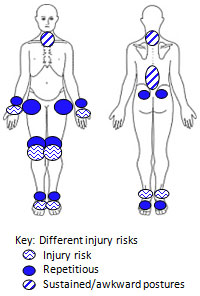Plant operator
The primary job task of the operator is to effectively operate heavy machinery in a safe and appropriate manner. Heavy machinery may include trucks, excavators, front-end loaders, dozers and graders. Tasks performed whilst operating machinery are performed whilst seated in a fully enclosed cabin with temperature controls and pneumatic adjustable seats. Operators may be exposed to vibrations over uneven terrain. An operator may also be required to perform other tasks outside of their plant whilst standing. Tasks are performed in an environment that includes dust, noise and uneven ground.
Tasks and tools used
- standing and walking over uneven surfaces and various gradients for prolonged periods
- seated operating heavy machinery
- spotting
- slinging pipe
- site inspections
- pre-start checks
- monitoring trench measurements
- store run
- operation of controls/levers
- getting in/out of machinery
Physical environment
- constant outdoor conditions, e.g. sun, wind, rain and variable temperature
- daylight
- medium machinery and equipment vibrations and noise
- constantly uneven and unstable terrain with variant degrees of gradient
- dust in dry conditions
Risks – potential musculoskeletal injuries
Heavy risk
- Ankle sprain: Constant inversion and eversion movements to counteract uneven and unstable surfaces.
- Wrist, forearm and elbow strain: Repetitive tasks such as gripping and usage of controls involving the wrist and forearm.
Medium risk
- Knee joint sprain, soft tissue strain: Excessive medial and lateral movement due to uneven and unstable surfaces and/or aggravation from higher muscle workload due to the terrain.
- Hip joint inflammation: Hip flexor tightness due to prolonged sitting.
- Lumbar muscle non-specific strain: Increased lumbar lordosis and erector spinae activation.
- Cervical muscle non-specific strain: Poor posture creating imbalances in neck flexors/extensors.
Light risk
- Plantar fasciitis: Prolonged standing and walking on uneven terrain.
- SIJ inflammation: Irritation from uneven body weight shift and absorbing lower limb body forces. Prolonged sitting with incorrect posture.
Critical physical job demands and other task requirements
| Critical job demand descriptor | % of time the task is performed | Task |
|---|---|---|
| Constant | >66% |
|
| Frequent | 34%–66% |
|
| Occasional | <33% |
|
Suitable duties
- goals must be clear, realistic and achievable
- must have 'buy-in' from the worker
- worker helps to set the goals, and must be answerable if goals are not met (this allows barriers to RTW to be identified at an early stage and obstacles overcome)
- workers need to understand they have an obligation to participate in rehabilitation and RTW as per Section 232 of the Workers' Compensation and Rehabilitation Act 2003 (the Act).
Return to work suggestions
Worker can begin with light duties and include more tasks as their capacity for work changes. We'll work with all parties, including the treating medical provider, employer and worker to ensure everyone is aware of where the worker is with their rehabilitation and stay at, or return to work.
Note: some tasks are dependent on worker's injury and capacity, and some tasks may require the assistance of a co-worker.
Offsite
Return to work can begin at home for those having difficulty with transport, medication or the injury prevents them from returning to work.
If the worker needs to take a break from work, they're rehabilitation can still begin at home. Tasks can include:
- video on safety issues can be viewed (lying in bed if injury type requires)
- computer-based programs, CDs or DVD on work-related subjects
- phone-based work
- emails
- training
- other worksite inductions
- checking or auditing paperwork, e.g. helping the WHSO audit lost time injuries (LTIs) for a six-month period.
Host employment
In the event an employer is unable to provide suitable duties, a host placement may be required. If this is the case, the worker may be placed at a different employer in a graduated return to work plan until they're able to 'upgrade' back to his/her pre-injury role with their pre-injury employer.
WorkCover Queensland's Recover at work program places injured workers in short term host employment with employers who have an established track record of successful return to work outcomes with their own workers.
More return to work resources
- View physical demands photos for Plant operator
